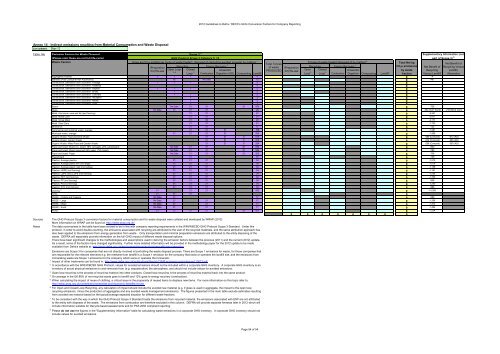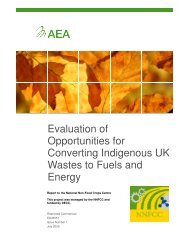Greenhouse gas conversion factors for company reporting
Greenhouse gas conversion factors for company reporting
Greenhouse gas conversion factors for company reporting
Create successful ePaper yourself
Turn your PDF publications into a flip-book with our unique Google optimized e-Paper software.
2012 Guidelines to Defra / DECC's GHG Conversion Factors <strong>for</strong> Company Reporting<br />
Annex 14 - Indirect emissions resulting from Material Consumption and Waste Disposal<br />
Last updated: Apr-12<br />
Table 14b<br />
Sources<br />
Notes<br />
Emission Factors <strong>for</strong> Waste Disposal<br />
(Please note these are not full life-cycle)<br />
Waste fraction<br />
Scope 3 2<br />
GHG Protocol Scope 3 Category 5, 12<br />
Gross kg CO 2e emitted per tonne of waste treated / disposed of (excluding avoided impacts) by method 1 :<br />
Total Tonnes<br />
Tonnes of waste treated /disposed of by method 4 :<br />
Total Net kg<br />
(Preparation<br />
Recycling<br />
Energy Recovery 7<br />
of waste<br />
CO 2e emissions<br />
(Preparation<br />
Recycling Energy Recovery 7 Net Benefit of<br />
Open Loop Closed<br />
Anaerobic<br />
Open Closed<br />
<strong>for</strong>) Re-use<br />
PRODUCED <strong>for</strong>) Re-use<br />
Anaerobic<br />
by waste<br />
Recycling<br />
3, 6<br />
Loop 3 Combustion Digestion (AD) Composting Landfill<br />
Loop 3 Loop 3 Combustion Digestion Composting Landfill fraction Versus Landfill<br />
Aggregates (Rubble) 1 1 1 2 0 -4<br />
Batteries (Post Consumer Non Automotive) 65 No Data 75 0 -487<br />
Construction, Demolition and Excavation: Average 1 1 1 2 0<br />
Construction, Demolition and Excavation: Asbestos 2 0<br />
Construction, Demolition and Excavation: Asphalt 1 1 1 2 0<br />
Construction, Demolition and Excavation: Bricks 1 2 0<br />
Construction, Demolition and Excavation: Concrete 1 1 2 0<br />
Construction, Demolition and Excavation: Insulation 1 2 0<br />
Construction, Demolition and Excavation: Metals 1 2 0<br />
Construction, Demolition and Excavation: Soils 1 2 0<br />
Books Data 21 553 0 No 21 21 -736<br />
Glass No Data 21 21 21 26 0 -392 (Col'r Sep'd) -216 (Mix'd Col's)<br />
Metal: Aluminium cans and foil (excl <strong>for</strong>ming) 21 21 21 0 -9,267<br />
Metal: Mixed Cans 21 21 21 0 -3,911<br />
Metal: Scrap Metal 21 29 20 0 -2,171<br />
Metal: Steel Cans 21 31 21 0 -1,723<br />
Mineral Oil 21 21 0 0 -725<br />
Commercial and industrial waste, average 21 21 21 199 0 -1,281<br />
Municipal waste, average 21 21 21 21 290 0 -1,969<br />
Organic Waste: Food and Drink Waste 21 21 6 570 0 -489 (Compost) -612 (AD)<br />
Organic Waste: Garden Waste 21 21 6 213 0 -272 (Compost) -265 (AD)<br />
Organic Waste: Mixed Food and Garden Waste 21 21 6 254 0 -296 (Compost) -380 (AD)<br />
Paper and board: Board (Av. board: 78% corrugate, 22% cartonboard) No Data 21 21 21 553 0 -820<br />
Paper and board: Mixed (assumed 25% paper, 75% board) No Data 21 21 21 553 0 -799<br />
Paper and board: Paper No Data 21 21 21 553 0 -736<br />
Plasterboard 21 72 0 -139<br />
Plastics: Average plastics 21 21 21 34 0 -1,215<br />
Plastics: Average plastic film (incl bags) 21 21 21 34 0 -1,076<br />
Plastics: Average plastic rigid (incl bottles) 21 21 21 34 0 -1,156<br />
Plastics: HDPE (incl <strong>for</strong>ming) 21 21 21 34 0 -1,161<br />
Plastics: LDPE and LLDPE (incl <strong>for</strong>ming) 21 21 21 34 0 -1,098<br />
Plastics: PET (incl <strong>for</strong>ming) 21 21 21 34 0 -1,705<br />
Plastics: PP (incl <strong>for</strong>ming) 21 21 21 34 0 -948<br />
Plastics: PS (incl <strong>for</strong>ming) 21 21 21 34 0 -1,240<br />
Plastics: PVC (incl <strong>for</strong>ming) 21 21 21 34 0 -888<br />
Clothing 5 21 21 21 552 0 -14,069<br />
Tyres 21 21 21 0<br />
WEEE No Data 21 0 - Fridges and Freezers 17 -656<br />
WEEE - Large No Data 21 21 17 0 -1,266<br />
WEEE - Mixed No Data 21 21 17 0 -1,374<br />
WEEE - Small No Data 21 21 17 0 -1,482<br />
Wood 21 21 21 21 21 851 0 -1,224<br />
The GHG Protocol Scope 3 <strong>conversion</strong> <strong>factors</strong> <strong>for</strong> material consumption and <strong>for</strong> waste disposal were collated and developed by WRAP (2012)<br />
More in<strong>for</strong>mation on WRAP can be found at: http://www.wrap.org.uk/<br />
The data summarised in the table have been revised to be in line with <strong>company</strong> <strong>reporting</strong> requirements in the WRI/WBCSD GHG Protocol Scope 3 Standard. Under this<br />
protocol, in order to avoid double-counting, the emissions associated with recycling are attributed to the user of the recycled materials, and the same attribution approach has<br />
also been applied to the emissions from energy generation from waste . Only transportation and minimal preparation emissions are attributed to the entity disposing of the<br />
waste. DEFRA will separately provide in<strong>for</strong>mation on the full GHG impact of different waste disposal options.<br />
There have been significant changes to the methodologies and assumptions used in deriving the emission <strong>factors</strong> between the previous (2011) and the current (2012) update.<br />
As a result, some of the <strong>factors</strong> have changed significantly. Further more detailed in<strong>for</strong>mation will be provided in the methodology paper <strong>for</strong> the 2012 update to be made<br />
available from Defra's website at: http://www.defra.gov.uk/environment/economy/business-efficiency/<strong>reporting</strong><br />
Emissions are Scope 3 <strong>for</strong> companies that are not directly involved in/controlling the waste disposal process. There are Scope 1 emissions <strong>for</strong> waste, <strong>for</strong> those companies that<br />
are responsible <strong>for</strong> the relevant elements e.g. the methane from landfill is a Scope 1 emission <strong>for</strong> the <strong>company</strong> that owns or operates the landfill site, and the emissions from<br />
incinerating waste are Scope 1 emissions <strong>for</strong> the <strong>company</strong> which owns or operates the incinerator.<br />
1 Impact of other treatments can be found in: http://www.defra.gov.uk/publications/files/pb13548-economic-principles-wr110613.pdf<br />
2 In accordance with the WRI/WBCSD GHG Protocol, values <strong>for</strong> avoided emissions should not be included within a corporate GHG inventory. A corporate GHG inventory is an<br />
inventory of actual physical emissions to and removals from (e.g. sequestration) the atmosphere, and should not include values <strong>for</strong> avoided emissions.<br />
3 Open loop recycling is the process of recycling material into other products. Closed loop recycling is the process of recycling material back into the same product.<br />
4 On average in the UK 88% of non-recycled waste goes to landfill and 12% goes to energy recovery (combustion).<br />
5 When calculating the impact of reuse of clothing, a critical issue is the propensity of reused items to displace new items. For more in<strong>for</strong>mation on this topic refer to:<br />
http://www.wrap.org.uk/content/environmental-and-economic-benefits-re-use<br />
6 For Open and Closed Loop Recycling, any calculation of impact should include the avoided raw material (e.g. if glass is used in aggregate, the impact is the open loop<br />
recycling emissions, minus the production of aggregates and any avoided waste management emissions). The figures presented in the main table exclude estimates resulting<br />
from avoided raw material based on the typical/average expected situation <strong>for</strong> different waste fractions.<br />
7 To be consistent with the way in which the GHG Protocol Scope 3 Standard treats the emissions from recycled material, the emissions associated with EfW are not attributed<br />
to the entity with disposes of the waste. The emissions from combustion are there<strong>for</strong>e excluded in this column. DEFRA will provide separate Annexes later in 2012 which will<br />
include in<strong>for</strong>mation suitable <strong>for</strong> lifecycle based assessments and <strong>for</strong> PAS 2050 compliant <strong>reporting</strong>.<br />
8<br />
Please do not use the figures in the "Supplementary In<strong>for</strong>mation" table <strong>for</strong> calculating waste emissions in a corporate GHG inventory. A corporate GHG inventory should not<br />
include values <strong>for</strong> avoided emissions.<br />
0 0 0 0 0 0 0 0<br />
Supplementary In<strong>for</strong>mation (not<br />
part of Scope 3) 8<br />
Net Benefit of<br />
Recycling Versus<br />
Landfill,<br />
Alternative<br />
Page 54 of 54








